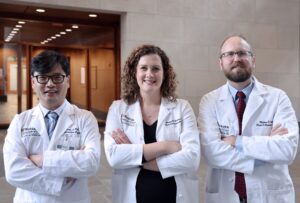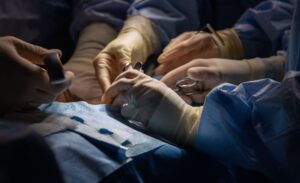Paths to Discovery
We believe that collaboration is the key to breakthroughs in patient care. When doctors and scientists from distinct specialties work together as a team, they can construct a treatment plan that otherwise wouldn’t be possible. We use this same multidisciplinary approach in our research program.
In our basic, translational and clinical labs, we put the greatest minds together – medical students, residents, fellows and faculty from many specialties – to find truly innovative solutions. Most recently, we’ve used multidisciplinary teams to explore tissue engineering and biomedical advances.
Biomedical Innovation
In partnership with Cortex Innovation Community and Washington University Office of Technology Management, several of our plastic surgeons are seeking new tools for patient care.
Mitchell Pet, MD, is collaborating with neurosurgeon Matthew MacEwan, MD, PhD, and Northwestern University researcher John Rogers, PhD, to develop novel wireless biosensors. These devices will introduce a more patient-centered treatment of post-operative free tissue transfers by providing reliable, noninvasive monitoring of blood flow and oxygen after tissue-transfer procedures.
Justin Sacks, MD, MBA, chief of plastic and reconstructive surgery, also is exploring new technology in the lab. His current work focuses on advancements in the field of tissue engineering, vascular anastomosis and tissue perfusion assessment. He is the co-founder of Lifesprout, a biotech startup which developed intellectual property around a novel tissue scaffold currently in its first human clinical trial. Dr. Sacks has further developed a pressure sensing device to help mitigate pressure sore development while in the in-patient setting and has initiated clinical trials. Work is also being performed on a sutureless anastomotic device, which will revolutionize the field of microvascular surgery.
Treating the Whole Person
Ida Fox, MD, is bringing biopsychosocial medicine to the forefront of reconstructive surgery in her study involving the potential for natural recovery after spinal cord injury. She is formulating surgery-decision aids to help patients make informed choices about nerve transfer surgery.


